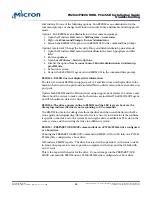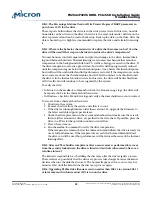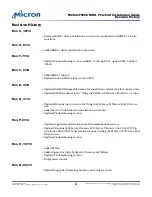
L-9: Enabling processor C-states can have a significant negative performance impact
on the P420m/P320h drive
On high-performance SSDs like the P320h and P420m installed in Nehalem- and Sandy-
bridge-class Intel CPUs, processor C-states can have a significant negative performance
impact. Enabling C-states actually starts disabling portions of the CPU core(s) when it
detects low/no-load conditions on the processor. This reduces the number of cores
available to handle incoming IO threads, which can reduce performance.
For optimal performance results, disable processor C-states prior to running IO on the
drive. To disable C-states, add the following to your kernel boot line:
intel_idle.max_cstate=0 processor.max_cstate=1
For more information on C-states, see
http://www.hardwaresecrets.com/article/611
L-10: NUMA rebinding may be required to obtain better IO performance on P420m/
P320h drives installed in some multiprocessor or multicore systems
When the Linux driver is loaded, each drive gets assigned a node in the /dev directory
with the 'rssd' prefix. These nodes are the entry points through which normal queued
IO is performed. The NUMA-aware Micron driver will place a node here called 'numa'
which will provide information on NUMA bindings it is using for the drive. To obtain
better performance on P320h/P420m drives, the IO submission threads must also be af-
finitized to the same node as the driver's device instance memory and IO completion
threads. The NUMA node the driver has bound the p320h/p420m device to, and the
processor where the node is located, should be same as that of the node which is physi-
cally close to the slot where the drive resides. Otherwise, IO performance could be sig-
nificantly reduced.
To rebind the drive's node to the NUMA node that the drive is physically close to:
1. Obtain the NUMA binding of device by entering the following command:
cat /sys/block/rssdX/numa
Sample output: Node: 0 (on package 0) PCI device closest to node 1 Device memo-
ry on node 0 Cores: 0 2 4 6 8 10 IRQ: 0 wq0: 0 wq1: 2 wq2: 4 wq3: 0 wq4: 2 wq5: 4
wq6: 4 wq7: 2
In the example output, the driver has bound the drive to processor node 0. Howev-
er, because the drive is physically close to processor node 1, you must rebind the
processor node.
2. Rebind the processor node by entering the following command:
echo "rssdX=Y" > /sys/module/mtip32xx/drivers/pci:mtip32xx/numa_bindings
Where: X = drive letter and Y = the node near the PCIe device
For example, if device
/dev/rssda
was used (one drive in the system) and node 0
was originally bound, but node 1 is physically closer, use the following command:
echo "rssda=1" > /sys/module/mtip32xx/drivers/pci:mtip32xx/numa_bindings
L-11: Which operating systems support orderly/surprise removal/insertion?
Orderly/surprise removal/insertion is supported on RHEL 6.x, RHEL 7.x, and SLES 11
SP2/SP3 OS versions only.
P420m/P320h HHHL PCIe SSD Installation Guide
Troubleshooting
PDF: 09005aef8497e00a
P420m_P320h_HHHL_installation_guide.pdf - Rev. V 12/14 EN
38
Micron Technology, Inc. reserves the right to change products or specifications without notice.
©
2012 Micron Technology, Inc. All rights reserved.
















































